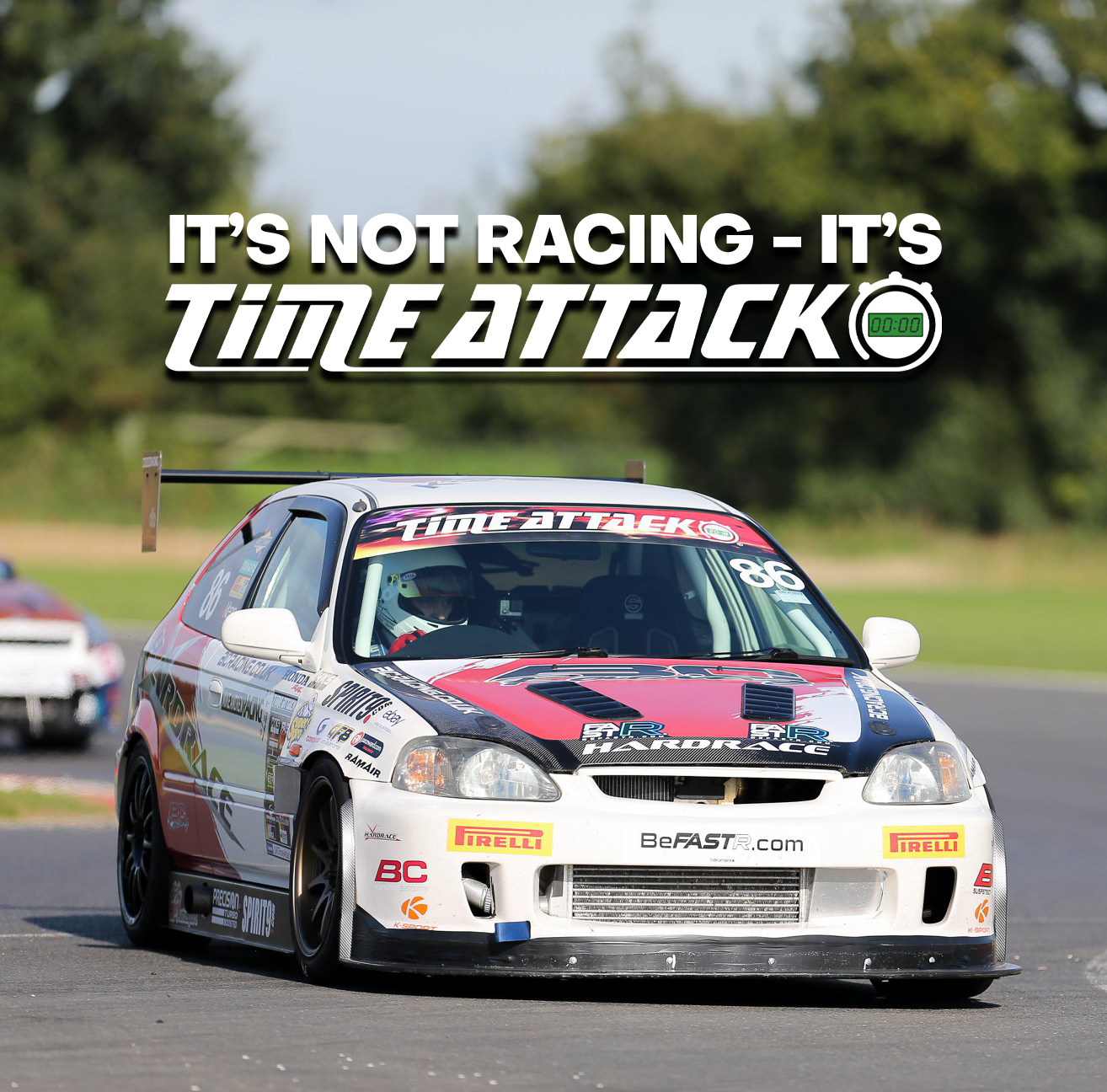It’s not racing…it’s Time Attack!

Having been involved with the UK Time Attack Championship for many years and now one of its main sponsors, we thought we would bring you an insight into this unique and hugely popular motorsport discipline that has its routes firmly embedded in the world of performance tuning.
To find out what it’s all about and why it continues to be one of the most followed forms of on-track activity on the planet, we caught up with championship coordinator since 2014 Simon Slade and asked him a series of questions that he was only too pleased to answer.
What are the origins of Time Attack?
Time Attack originated in Japan back in the early 1980s. It was around the time that Japanese manufacturers started to introduce performance variants into their model line-ups, which then kicked off the tuning culture over there – in a big way.
Things then went crazy and a series of tuning shops sprung up, each vying to be the best. The way of measuring their level of engineering ability was by the amount of time (or least amount of time) it took to cover a set distance. It could be in a straight line, over a given section of road, or a loop around the block. But there was a problem, all this took place on public roads and it didn’t take long before the shoot-out for supremacy was moved onto the track.
The venue chosen is now legendary in the sport: Tsukuba Circuit, located in Shimotsuma near Tsukuba in the Ibaraki Prefecture. It’s 1.271 miles long and where Time Attack, as we know it today, officially began.

When did it come to the UK and how has it developed here since?
Championship owner Andy Barnes was a competitor himself and with business connections in Japan he heard about this relatively new form of motorsport that was surrounded by its own unique culture and rapidly growing in popularity. Accompanied by Glen Horncastle, who went on to coordinate and manage the championship for eight years, Andy took a trip to Japan to see what it was all about and, after many conversations and a series of successful negotiations, introduced the sport into the UK.
The first ever ‘Time Attack’ format event took place at the end of 2005 at Rockingham. As it was purely a suck-it-and see exercise, the event was branded ‘GT Battle’ and attracted more competitors than Andy and Glen could have hoped for. Encouraged by the enthusiasm surrounding the event and the feedback received, the very first Time Attack season went ahead as a championship in 2006.
Whilst the classes have changed and details have been tweaked along the way, that inaugural season set the parameters for the UK Time Attack Championship. From then on the format has remained the same, with all classes taking part in a Warm-up and Qualifying session in the morning, followed by a Qualifying and Final session on the afternoon. Results are decided by the fastest lap set in the Final, with championship points scored in Qualifying (1st-5th) and the Final (1st-10th).
We understand there’s a class for almost every type of car?
Yes, there is. We are proud of the fact that our classing structure not only makes most cars eligible to compete in Time Attack – from a standard road vehicle to a full-on racing machine - but enables them to compete on a competitive basis by establishing a carefully thought out criteria on the modifications allowed in each class.
The entry-level category is actually outside the championship itself; the Run What You Brung class. This was introduced in 2019 and enables drivers who have never competed before to take the first step into their motorsport journey. All you need is a standard car and with a few very minor additions and the right driver clothing, you’re ready to go!
The main championship starts with the Clubman Class for cars that are closest to standard hand have a mild amount of modification, whilst Pocket Rocket allows modified cars with smaller engines, such as hot hatches and compact sports cars.
Club Class cars feature off the shelf tuning mods, but are restricted to the level of changes that can be carried out. They are also required to run on road-based tyres. This rule also applies to the Club Pro Class for dry conditions – although they can run racing wets when it rains - whilst the GT3/Sportcar and Pro-Extreme Classes are able to run on slicks and super-soft tyres. This dramatically enhances the level of grip and consequently, teams are able to increase power outputs, which means that some of the cars develop in excess of 1000 horsepower!
So what is the format for the day?
As mentioned, there are four sessions during the day, with these sessions further split into three to accommodate the classes and make things competitive, as follows:
Session 1
Clubman: Road & track day cars
Pocket Rocket: Smaller engined cars & hot hatches
Session 2
Club Challenge: Two-wheel-drive modified cars
Four-wheel-drive modified cars
Session 3
Club Pro: Highly tuned cars running on road tyres
GT3 & Sportscar: GT and sports racing cars
Pro-Extreme: Cars with unlimited modifications on slicks
Session 4
Run What You Brung: All types of car, with minimum levels of modification and no restriction on the make of tyre, although slicks are not allowed.
How easy is it to get involved and can you give us an idea of what you need and how much it’s likely to cost?

It’s really easy to get involved. In fact, we believe that Time Attack is the most accessible, easy-to-enter and best value-for-money form of motorsport on the market. For instance, if you take the Run What You Brung class, all you need for the car is a 4-point harness and a 1.75-litre hand-held fire extinguisher. Then for the driver, it’s an approved racesuit, helmet, gloves and boots – and that’s it!
Entry for a single RWYB round starts at £200 and for that drivers get their Club membership, licence and transponder hire included FOC for the first event. If you then take off the VAT, it works out at less than £100 for the day and an hour’s track time on a proper circuit, in full-race conditions and usually, in front of 1000s of spectators. What’s not to like!
Moving on to the full championship, currently the cost for entering a round in the Clubman and Club Classes is £360 and in the Pro Classes, it’s £420. It works out cheaper if you sign up for a full season though and we have a range of payment plans so that drivers can spread the cost throughout the season if they prefer. And, if they register for the full season they will also be able to score championship points, which you don’t if you enter on a round-by-round basis.
What do you think sets Time Attack apart from other forms of motorsport and why do you think it appeals to a different demographic?
It’s because of its origins that makes Time Attack different. It’s the purest form of road-to-track motorsport on the planet and because of that, it embraces modified car culture perfectly and therefore appeals to the millions of people around the world who are part of this continually evolving global automotive movement.
In fact, Time Attack is so different in 2016 it was added to the Motorsport UK (the sport’s governing body in Britain) national rules and regulations and consequently, it is now officially a specific form of motorsport in its own right. Interestingly, this was the first time that a new motorsport discipline had been included by MSUK for over four decades!
Our strapline is ‘It’s not racing…it’s Time Attack’. And it really isn’t racing. If anything, it’s more like qualifying. Whilst some of the motorsport traditionalists don’t get it, you’ve only got to look at F1 and very often, the qualifying sessions are more exciting than the race itself!
When you drill down to it, it’s a more-focussed discipline. You have to nail the perfect lap. There’s no letting off when you’re in the lead because you have a gap to fall back on. You don’t know what your rivals are doing, so you’ve got to push-push-push, all of the time.
To achieve this, it’s not only down to the driving. It’s about car preparation and set-up. And if that doesn’t work, then the team has to go back to the workshop and make changes to the car, whether it’s to the engine, transmission, suspension, brakes or aero. Then, they come back and try again.
We are proud to have one of the most open and flexible series of technical regulations to that of any championship. We have to, to include the range of cars that compete in the championship, albeit carefully categorised into specific classes to ensure the competition remains close and fiercely fought.
It’s this ability to progressively modify what starts out as a standard road car into – if an owner wants to - into a full-race, lap-record-setting monster that sees Time Attack appeal to the Performance Tuning demographic more than any other form of motorsport.
This is another reason why we hold the supporting shows alongside the Time Attack rounds. These attract the 1000s of street-based car clubs from around the country – and it’s this combination of static displays and on-track action appealing to real car enthusiasts and petrol heads. This means we regularly enjoy huge crowds and many of our events, coupled to a massive on-line following, which in-turn keeps the competitors, traders and importantly our sponsors happy – we hope!
Well Simon, that’s quite an insight. I can really see why there’s so much buzz around the championship. Many thanks for sharing your knowledge and thoughts with us. We wish you and the championship all the best for the future.
Thanks, you’re most welcome – and thanks for the continued support!
















